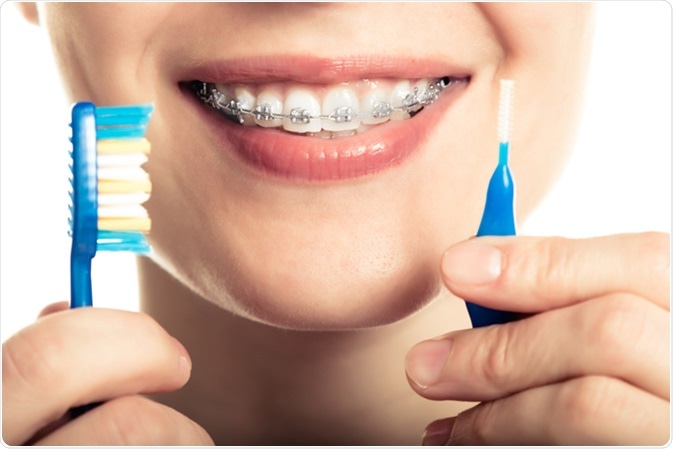Maintaining good oral hygiene is one of the most crucial aspects in determining the overall prognosis of an orthodontic treatment.
Food particles entrapped in orthodontic appliances like braces or brackets allows the accumulation of plaque and accelerates the attack on the teeth by oral microorganisms resulting in dental complications like caries.
Appropriate oral hygiene includes professional dental guidance, the use of the right tools, and patient motivation.
The first step that an orthodontist employs is educating the patient about the need of oral hygiene during the course of an orthodontic treatment.
The primary goal is to attain a behavioral change in the patient. A study revealed that this process should include continuous and active reminders by the dentist over the phone.
This results in a positive behavioral change along with increased awareness on disease prevention.

Image Credit: Khamidulin Sergey / Shutterstock
Self-Measures for Good Oral Hygiene Post-Braces
Brushing and flossing - Dentists usually recommend the use of a small-sized toothbrush for brushing post-application of braces. A small-sized brush can easily reach all the areas, allowing finer and more thorough brushing. Polished nylon bristles with a soft and flat brushing surface are usually preferred; however, specialized brushes with much finer details may be recommended by the dentist.
Brushing teeth with fluoride toothpaste is vital as fluoride protects the teeth against tooth decay. Maintaining good oral hygiene under normal conditions may require brushing twice a day. However, when braces are being used, it is usually recommended that brushing be carried out at least five times a day, with each brushing session lasting at least five minutes.
Also, brushing is recommended post consumption of each meal during the day. It is advisable to brush before sleeping primarily to counter the increased bacterial activity during the nocturnal hours due to reduced salivary flow during this time.
Ideal Brushing Steps
- Begin brushing from the top of the brace/bracket and aim right towards the tooth. Also, brushing back and forth is recommended.
- Properly clean the area under the brace/bracket using a back and forth movement to ensure proper cleaning
- Brush the occlusal (biting surface of tooth) and lingual aspect (tooth area facing the tongue)
- Use light circular motions while brushing the teethto prevent any damage to the braces
Regular flossing is as important as brushing in these cases, as flossing removes food trapped in the braces. To appropriately perform flossing, the steps below are important:
- Cut a long piece of dental floss so that it can be easily folded around the index fingers of both hands.
- Place a loop of the floss between the brace wire and the teeth. The floss must be aligned to the space between the gums and the teeth.
- Hold the ends of the floss firmly folded around the index fingers. This ensures a proper grip and allows the desired movements to be made without harming the gums and braces.
- Gently remove the food entrapped between the teeth and accumulated plaque. To ensure gentle cleaning, it is advisable to hold the floss in a ‘C’-shape around the teeth rather than keeping the floss in a straight position This vertical movement ensures minimal damage and proper cleaning.
It is vital to learn the appropriate brushing and flossing technique from an orthodontist after application of braces.
What Foods Should be Avoided While Wearing Braces?
Masticating hard foods can lead to the breakage of braces. Once the braces stop adhering to the tooth surface it can become loose and does not serve the desired function. In general, soft foods are preferred over hard and crunchy foods. Some foods which should be avoided are:
Hard foods: Foods that require an effort to bite into, such as bagels, hard rolls, apples and nuts, should be eaten after cutting them into smaller pieces.
Sticky foods: Foods which adhere to the tooth surface should be avoided as they tend to stick to the tooth surface for a longer period of time. Some examples include caramels, chewing gums, and candies.
Sugary and processed foods: Foods like candies and sugary beverages can promote demineralization and result in subsequent tooth caries.
Crunchy foods: Foods like popcorn and ice should be completely avoided during an orthodontic treatment as the force used to crush them inside the mouth can lead to the breakage of the braces.
Besides the above mentioned methods, it is recommended to protect braces against any external damage. It is advisable to refrain from activities which involve interpersonal violence and accidents. For athletes and other sportspeople it is advisable to wear a mouth guard while playing. Also, a regular follow up with the dentist ensures professional cleaning and the most appropriate care.
Further Reading